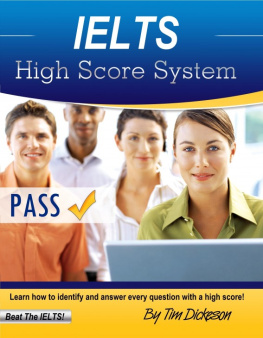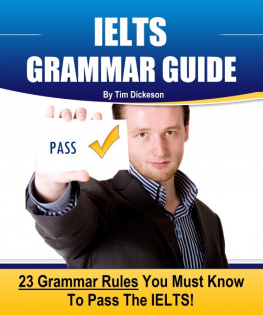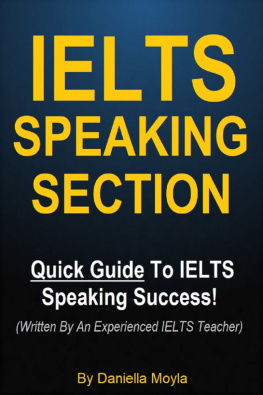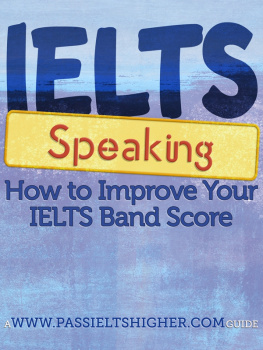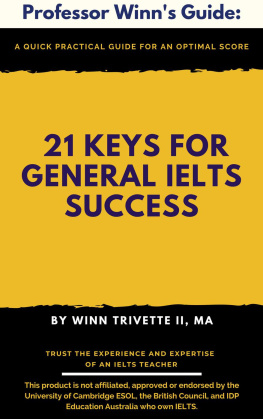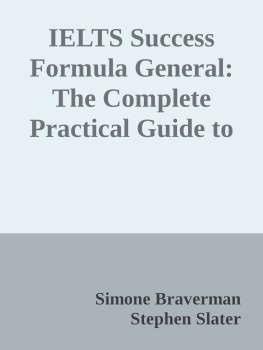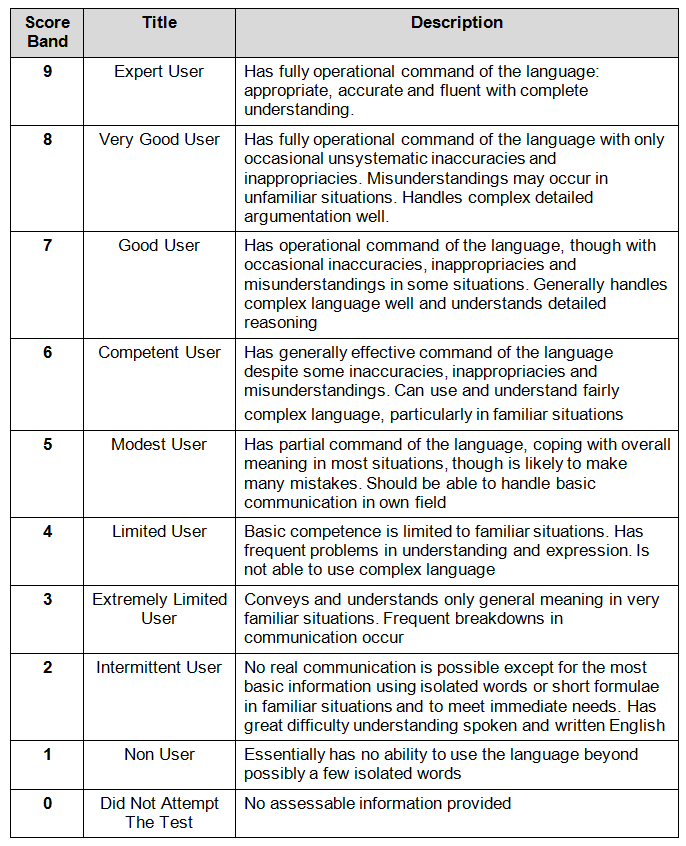IELTS HighScore System
Learn How ToIdentify & Answer Every Question With A High Score!
By TimDickeson
Copyright by Tim Dickeson 2014
Published by Sanbrook Publishing
Smashwords Edition
Limits ofLiability / Disclaimer of Warranty:
The authorand publisher of this book and the accompanying materials have usedtheir best efforts in preparing this program. The author andpublisher make no representation or warranties with respect to theaccuracy, applicability, fitness, or completeness of the contentsof this program. They disclaim any warranties (expressed orimplied), merchantability, or fitness for any particular purpose.The author and publisher shall in no event be held liable for anyloss or other damage, including but not limited to special,incidental, consequential, or other damages. As always, the adviceof a competent legal, tax, accounting or other professionals shouldbe sought.
This manualcontains material protected under International and FederalCopyright Laws and Treaties. Any unauthorized reprint or use ofthis material is prohibited.
IELTS isjointly owned by British Council, IDP: IELTS Australia and theUniversity of Cambridge ESOL Examinations (CambridgeESOL).
ISBN:9781311137432
*****
Table of Contents
Who This Book Is For
This book is for anyone who is about to take the IELTS examand wants direct instructions for how to identify and answer everyquestion with a high score.
This material is perfectfor you if:
You dont know whatyou should be focusing on in your preparation and you want to knowwhat the examiners will look for.
You are feelingnervous about your speaking because you think it wont be goodenough.
You dont know howto correctly structure your essays and you dont know how todevelop a high scoring essay.
You have taken theIELTS before but didnt get the score you wanted and you dont knowhow to increase your score.
You will take theIELTS soon and you information in a step-by-step system.
Module 1 IELTS Outline
WhatIs The IELTS?
The IELTS (InternationalEnglish Language Testing System) is a test that evaluates theEnglish proficiency of people with English as a second language whowould like to work or study where English is used as the primarycommunication language (usually in English speakingcountries).
The IELTS test measuresEnglish proficiency covering: listening, reading, writing andspeaking, and uses a 9-band scale to indicate proficiencylevel.
IELTS is required forpeople who want to study at secondary and tertiary level and forthe application of visas and employment.
The TwoTest Modes (Academic / General Training)
IELTS provides two typesof test modes and the type of test mode that you will need to takewill depend on your circumstances. The two test modes are; Academicand General Training. Lets look at the difference between the twotest modes.
Academic Evaluates English languagecompetency for academic and tertiary purposes.
For example University,TAFE
GeneralTraining Evaluates English languagecompetency in a practical, living context.
For example Employment,Visas
Note: The Academic and General Training test modes aregraded using the same criteria for the writing section of theIELTS.
Scoring Structure How IELTS Will ScoreYou
Your IELTS score will begiven between 0 9 for each of the four sections and then anoverall score given between 0 9.
Below shows the scoringrange for each section and the overall score.
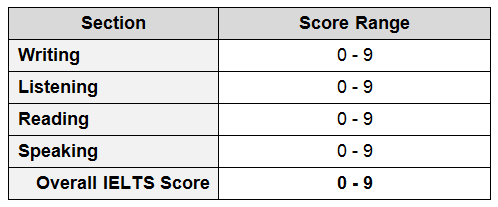
The score bands as shownbelow outline the competency of the student and the scores aregiven in 0.5 point increments.
Module 2 Listening
Unit 1 Listening Introduction
Objective ofthis Unit : To understand what the Listeningsection is and what the different question types are.
What Is The Listening Section?
The second module that wewill look at is the listening section. The listening sectionmeasures how well you can listen for main ideas, specificinformation, supporting information, facts and opinions.
ListeningSection Structure
Four sections eachsection has 10 questions.
Questions appear inorder in the listening passage.
AnswerFormat
Time is given toread questions and write down and check answers.
Answers are writtenon question paper as candidates listen.
When recordingfinishes, candidates have ten minutes to transfer answers ontoanswer sheet.
Timing
Approximately 30minutes plus 10 minutes transfer time for answers.
Marks
Each question isworth one mark, giving a total of 40 marks.
FourListening Sections

Listening Section QuestionTypes
There are 6 differentquestion types in the listening section:
1. MultipleChoice
2. Matching
3. Map, Plan, DiagramLabelling
4. Table, Note, Form,Flow-chart, Summary Completion
5. SentenceCompletion
6. Short AnswerQuestions
1. MultipleChoice
What are yourequired to do?
You will be given eitherthe beginning of a sentence with three possible sentence endings ora question with by three possible answers.
You need to choose one ofthe answers.
Tip: Sometimes, there may be a longer list of answerswhere you will need to choose more than one.
Tip: If you are unsure of the correct answer, use theprocess of elimination to help identify the correctanswer.
ExampleQuestion:

2.Matching
What are yourequired to do?
You are required to matcha list of items from the listening passage which are numbered, to alist of possible options.
Tip: Listen for key words from thequestion.
ExampleQuestion:
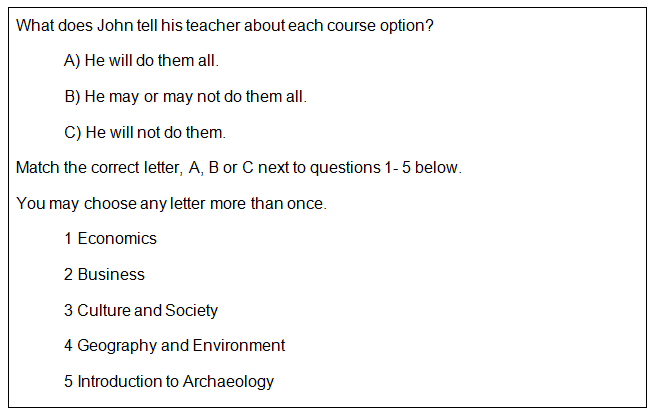
3. Map, Plan,Diagram, Labelling
What are yourequired to do?
You will be given a list of labels to complete on a visual diagram. The visualdiagram may be a; picture, diagram, plan or map.
Tip: Listen for directions and spatialrelationships, e.g. straight on, through the far door, across thestreet
ExampleQuestion:

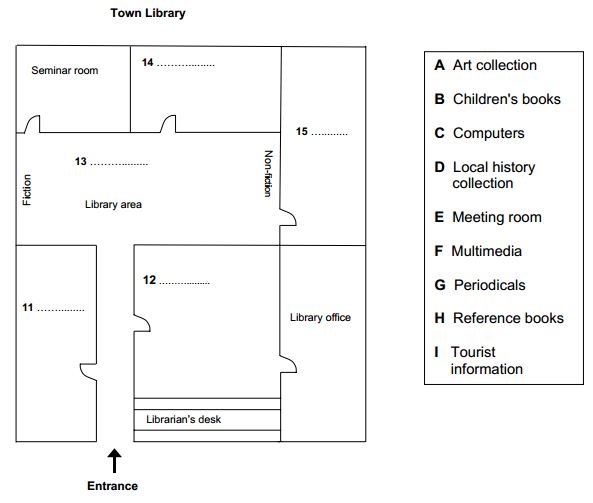
4. Table, Note, Form,Flow-chart, Summary Completion
What are yourequired to do?
You are r equired tocomplete the breaks in a summary of the listening text. The summarywill concentrate on the main ideas in the text.
Form used to recorddetails.
Next page
